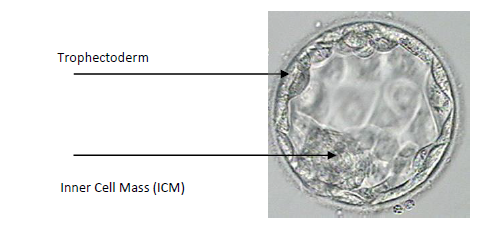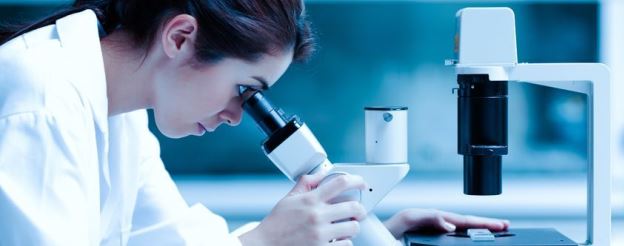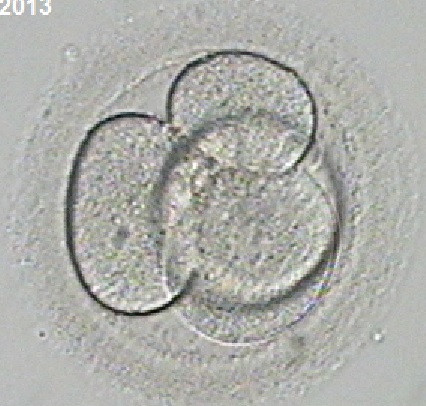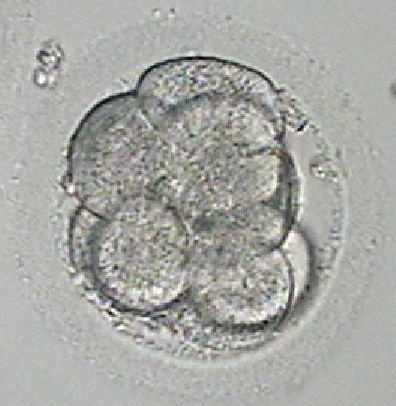What is Cleavage Stage Transfer?
Cleavage Stage Transfer refers to the transfer of an embryo back into the uterus on Days 2 or 3 (Day 1 is the day of fertilisation). Generally, at this stage of development the embryo will exhibit distinct cells within the embryo, usually 2-4 cells on day 2 and 6-8 cells on day 3 (see images below). Cleavage stage embryos are selected by evaluating the number of cells present in the embryo, evenness of the cells (or blastomeres) and degree of fragmentation.
Fragmentation occurs when an embryo goes through the division process, although not all embryos will show signs of fragmentation. Some degree of fragmentation has been reported to occur in about 80% of IVF embryos. If you consider a single cell splitting into two, it is possible that during this division process that the embryo doesn’t divide perfectly evenly and leaves some parts of the cell behind. An analogy that I sometimes use is when you break a biscuit, sometimes you have a perfect break with no crumbs and other times there will be crumbs left behind; the crumbs from the biscuit are the fragments from the cell.
Embryos at the cleavage stage of development are driven by the maternal genome and subsequently failure to continue to grow past this stage are thought to be associated to oocyte quality.
What is a Blastocyst Stage Transfer?
Blastocyst Stage Transfer refers to the transfer of an embryo (hopefully a blastocyst) back into the uterus on Day 5-6. A blastocyst is the name given to an embryo which has developed into a single-layered sphere of cells encircling a fluid-filled cavity, with a dense mass of cells grouped together (see image below). It has been reported that a blastocyst contains anywhere from 60 to 120 cells. By this stage, the embryo has differentiated into two cell types; the trophectoderm, the cells on the periphery of the embryo that forms the placenta; and the inner cell mass (ICM), the dense mass of cells on the inside that forms the foetus if the embryo implants.
It is expected that on average, only a third of the embryos which fertilise normally will continue to develop to the blastocyst stage, which will be suitable for transfer and/or freezing. This is because embryos are driven by the embryonic genome between days 3 and 5. At this stage the embryos continual development is reliant on the embryo itself to provide it with everything that it needs. It is thought that embryos that continue to fail to develop between days 3 to 5 could be associated to sperm quality.

Figure 3: DAY 5 (Expanded Blastocyst)
The Benefits Of Culturing Embryos To Blastocyst Stage
- The major benefit of culturing an embryo to the blastocyst stage is that it acts as an embryo selection or viability tool. Let’s say during your cycle you have three oocytes that fertilise normally, based on averages, you will only have one which is still progressing by day 5. However, it is likely that 2 or 3 of these embryos would have been still developing at the rate we expect to see (6-8 cells) on day 3. Therefore, continuing to culture embryos to the blastocyst stage allows the Scientist to choose the best embryo for transfer, giving you a higher chance of success.
- If an embryo survives until Day 5 it is more likely to be genetically normal. However, this does not mean all Blastocyst embryos are genetically normal.
- Increased implantation rates by culturing of the human embryo beyond the activation of the embryonic genome.
- It is thought that transferring embryos at the blastocyst stage they may have a better potential to implant into the uterus. This is because in a natural cycle, Day 5 is usually when the embryo moves out of the fallopian tube and into the uterus. It has therefore been said that transferring an embryo at this stage into the uterus, is more like a natural cycle with better synchronisation between uterine lining and embryo development.
- Blastocyst cryopreservation (freezing) is more efficient than cleavage stage cryopreservation. This is because blastocyst embryos have a higher developmental potential, thus the implantation and pregnancy rates following frozen embryo transfer (FET) of blastocysts are higher compared to early cleavage FET.
Things To Consider In Your Decision
- Some fertility specialists consider that the woman’s uterus is the best incubator and therefore embryos should be put back into the uterine environment as soon as possible. Whilst there have been recent advances in Blastocyst culturing media, it is still not known if this in vitro (in glass) environment is as good as the natural environment of the uterus; this is because there is no way of studying an embryo in-vitro and in-vivo (in body) at the same time.
- There is a risk that none of your embryos will survive until Day 5, therefore an embryo transfer would not be performed. This risk can be up to 10%. Some patients struggle with the thought that they have undergone an IVF cycle to this point and yet may not end up with an embryo suitable for transfer. Therefore, generally if you have less than three (3) oocytes fertilised normally it may be suggested to perform a cleavage stage transfer, however you can always request that the Scientist continues to culture your embryos to day 5 and transfer on this day if suitable.
- Perturbed sex ratio. It has been suggested that there is a bias towards the birth of male offspring following blastocyst culture and transfer compared to cleavage stage transfer.
- The safety of prolonged culture and transferring at Blastocyst stage has not yet been established in long-term studies, however initial findings have not demonstrated any increased risks.
Further Questions
If you or your partner have any questions or would like to arrange a free consultation with a scientist to discuss these options please phone us for an appointment.



